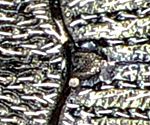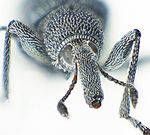Curvy-nosed hollyhock shrew weevil
| Curvy-nosed hollyhock shrew weevil | ||||||||||||
|---|---|---|---|---|---|---|---|---|---|---|---|---|

Curvilinear hollyhock weevil |
||||||||||||
| Systematics | ||||||||||||
|
||||||||||||
| Scientific name | ||||||||||||
| Alocentron curvirostre | ||||||||||||
| ( Gyllenhaal , 1833) |

|

|
| Fig. 1: side view | Fig. 2: head |

|
|
| Fig. 3: Label (brownish) | Fig. 4: Underside of the trunk |

|
|
| Fig. 5: Bottom | Fig. 6: Front view |
The Krummrüsslige Hollyhocks-Spitzmausrüssler ( Alocentron curvirostre ) is a beetle from the subfamily of Apioninae within the family of brentidae (Brentidae). Alocentron has traditionally been listed as a subgenus of the Apion genus . In Europe there is no other species of the genus Alocentron apart from Alocentron curvirostre .
The part of the name "Krummrüsslig" is the translation of the species name curviróstris (from Latin "cúrvus" "curved" and "róstrum" "trunk") into German and names the curved trunk. The animal occurs almost exclusively on the hollyhock and the shrew weevil part of the name indicates that it belongs to the species traditionally grouped under apion .
Characteristics of the beetle
The small beetle with the typical pear-shaped figure of the Apioninae reaches an average length of just over three millimeters. The coloration with metallic blue to blue-green elytra and less metallic shiny as well as darker head and pronotum can be found in many species of the family.
The flat head extends forward into a very characteristic trunk, which in the female is about as long as the head and pronotum together, and in the male a little longer. In contrast to the other species of the subfamily, the trunk is quite thick, consistently thicker over the entire length than the thighs of the forelegs. In addition, it is evenly strongly curved and densely punctured . On the underside it has a wide groove, which is covered with very fine hairs (Fig. 4). The eleven-segment antennae are not kneeled; the last three antennae-segments form a pointed club that is more than twice as thick as the thin antennae. The slightly offset tip of the club simulates a fourth club link. The eyes are longitudinally oval and only slightly protruding (Fig. 2).
The pronotum is narrowed towards the front and slightly constricted just behind the front edge (Fig. 2). Like the head and trunk, it is densely dotted.
The elongated oval elytra are as wide at the base as the pronotum, but widen to the rear in an elongated ovoid shape and are rounded off together. They have fine dot stripes with wide spaces. These are very hairy. The label is deepened in the shape of a channel (Fig. 3).
The thighs and splints are toothless, the tarsi four-limbed. The claws are widened tooth-shaped at the base.
biology
The species belongs together with Aspidapion validum and Rhopalapion longirostre to the three Central European species of the family that develop almost exclusively in the hollyhock . Other host plants are also reported from Israel. All three species have their home in the east and have only been able to establish themselves in Central Europe in recent years. The adults can be found on the host plant from May to August.
The stenotopic species inhabits habitats that are warm and dry. The few finds in Baden-Württemberg are between 270 and 635 meters high. The adults eat leaves, the larvae develop in the pith of the stems.
distribution
The species occurs in a strip from Poland to Bulgaria , also in the southern part of European Russia and in Western Asia. In the German-speaking area, older reports are only available from Austria . The species is spreading. In 2005 it was first proven for Germany . However, Reitter also mentions Bavaria as a place of discovery.
literature
- Edmund Reitter : Fauna Germanica, the beetles of the German Empire V. Volume, KGLutz 'Verlag, Stuttgart 1916
- Heinz joy , Karl Wilhelm Harde , Gustav Adolf Lohse (ed.): The beetles of Central Europe . tape 10 : Bruchidae – Curculionidae 1 . Goecke & Evers , Krefeld 1981, ISBN 3-87263-029-6 .
- Klaus Koch : The Beetles of Central Europe . Ed .: Heinz Freude . tape 3 : ecology . Goecke & Evers, Krefeld 1992, ISBN 3-87263-042-3 .
- Gustav Jäger (Ed.): CG Calwer’s Käferbuch . K. Thienemanns, Stuttgart 1876, 3rd edition
Web links
- Profile Alocentron curvirostre (Gyllenhal, 1833) at the Association of Southwest German Coleopterologists (ASK) ( memento from March 25, 2016 in the Internet Archive ).
- Distribution map of Alocentron curvirostre. In: Christoph Benisch: The beetle fauna of Germany.
Individual evidence
- ↑ a b Alocentron curvirostre in Fauna Europaea. Retrieved September 13, 2012
- ↑ Alocentron at Fauna Europaea. Retrieved September 14, 2012
- ↑ cf. Sigmund Schenkling: Explanation of the scientific beetle names from Reitter's 'Fauna Germanica' (species). Stuttgart: KG Lutz, 1917.
- ↑ Käfergesellschaft an Alcea rosea. The beetle fauna of Southwest Germany, Association of Southwest German Coleopterologists (ASK) ( Memento from March 4, 2016 in the Internet Archive ).
- ^ Distribution map Alocentron curvirostre. ASK - Die Käferfauna Südwestdeutschlands ( Memento from September 29, 2017 in the Internet Archive ).
- ↑ Klaus Koch : The beetles of Central Europe . Ed .: Heinz Freude . tape 3 : ecology . Goecke & Evers, Krefeld 1992, ISBN 3-87263-042-3 .
- ↑ Profile Alocentron curvirostre (Gyllenhal, 1833). ASK - The Beetle Fauna of Southwest Germany ( Memento from March 25, 2016 in the Internet Archive ).
- ^ Edmund Reitter : Fauna Germanica, the beetles of the German Empire, 5th volume, KG Lutz Verlag, Stuttgart 1916.

